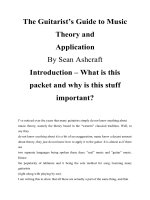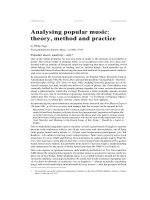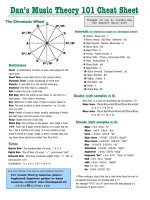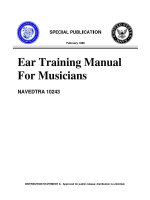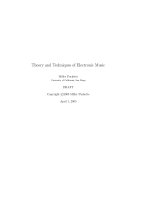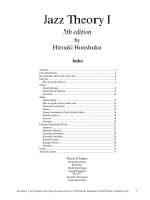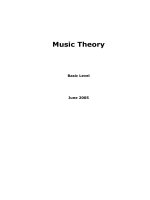Music theory jazz theory
Bạn đang xem bản rút gọn của tài liệu. Xem và tải ngay bản đầy đủ của tài liệu tại đây (562.35 KB, 33 trang )
Jazz Theory I, New England Conservatory Extension Division, ©1997 Hiroaki Honshuku (A-NO-NE Music, Cambridge, MA)
- 1 -
Jazz Theory I
5th edition
by
Hiroaki Honshuku
Index
Notation 2
Class Restrictions 4
Key Signature (the Circle of the 5th) 5
Intervals 6
How to get the Interval 7
Chord
Chord Structure 8
Chord Tone & Tension 9
Inversion 10
Mode
Church Mode 12
How to get the correct mode scale 13
Tension & Avoid Note 14
Tritone 15
Tritone Substitution Chord (Altered Mixo) 16
Melody Analysis 18
Exercise 19
Summary 20
Diatonic Functioning Chord 21
Analysis 22
Harmonic Rhythm 23
Secondary Dominant 24
Extended Dominant 26
Related II minor 27
Example (Peace) 28
Summary 31
Project 32
About the author 33
Theory II Subject
Diminished Scales
Minor Key
Modal Interchange
Special Dominant
#
IV-7
(
b
5)
Deceptive Resolution
Compound Chords
- 2 -
Jazz Theory I, New England Conservatory Extension Division, ©1997 Hiroaki Honshuku (A-NO-NE Music, Cambridge, MA)
Notation
←
Same space as the
Extended
• Treble Clef (G Clef)
Starts from the bottom, should make
a sharp top, and circle the note G.
• Bass Clef (F Clef)
Starts from circling the
note F (4th line).
• Flag
The direction of the flag is the same
side of the note head, going down, and
up.
• Note Head
30˚ right up angle.
• Quarter Rest
Starts from the bottom.
Note that the starting circle
is on the 2nd line.
• 8th Rest
Should fit be-
tween the 2nd and
the 4th line.
→
→
• Notation is the most profound communication tool between the composer and the performer. If the
music is not notated clearly, the performer will fail to sight read. The composer, most likely, has to
be present at the rehearsal, and the performer will demand more payment for the over work. On the
other hand, if the music is written perfectly clear, the performer will be blamed for a bad perfor-
mance. As most of the college assignments will not accept hand written paper, this class requires
basic notation skill by hand. The assignments done by unreadable hand writing or notated by
computer will not be graded.
• Basically, a right up angle of 30˚ should be kept in mind. This angle is the maximum and/or
comfortable angle to the sight reader's eyes.
TIP Unlike written language, music notation is very psychological to the sight reader. You must
pretend to be a a performer reading the music for the first time, trying to get all the necessary
information (tempo, dynamics, articulations, etc.) as quick as possible.
• Important: Each
ledger must be
the same size as
the staff space. If
the ledger lines
→
are more than two, the length of the stem is extended to
the 3rd line.
8va
• Stem
The length of the stem is an 8va. The
direction of the stem switches at the 3rd
line.
staff space
Jazz Theory I, New England Conservatory Extension Division, ©1997 Hiroaki Honshuku (A-NO-NE Music, Cambridge, MA)
- 3 -
• The direction of the beam is decided by the first and the last note. However, it is better to
use a leveled one when many notes in the beam are distant.
↑
↑
↑
↑
↑
↑
Leveled
• The Beam Angle
Should not exceed 30˚.
• Imaginary Bar Line
An imaginary bar line is a line drawn in the middle of a measure that has a time signature in
even beats (2/4, 4/4, 6/8, 12/8 etc.). It is a sub-division of a bar.
The dotted quarter on the 2nd
beat crosses the Imaginary bar
line which makes it harder to
read. The sight reader will not
be able to tell the time signa-
ture of the piece without going back to the top of the piece. Therefore, it must be written as
shown in the 2nd bar.
Exception to this rule is when the note value is bigger than 2
beats (half note in this case), because it is not as difficult to
identify the imaginary bar line in sight reading.
• Space
Spacing is one of the biggest issues. If each note is not spaced in relation to the others, the sight
reading will not be easy.
The example on the first measure here makes sight reading almost impossible. You have to
rewrite it as in the 2nd measure.
- 4 -
Jazz Theory I, New England Conservatory Extension Division, ©1997 Hiroaki Honshuku (A-NO-NE Music, Cambridge, MA)
ssalcsihtnireveNssalcsihtnihcumyrevderefrP
rojaM
ronim
ht5dettalfhtiwht7ronim
detnemuguA
dehsinimid
snoisnethtiwdrohC
X CM7
X C
y
7
C-7
C-7
(
b
5)
CAug7
Cdim7
C7
(
b
9
)
CMaj7
X Cm7
X C
ø
7
X C+7
X C
o
7
X C7
b
9,
b
13
b
13
Never "Half Diminished"!
There is no diminish function.
Class Restriction (the big rules)
* The neat manuscript skill is required as described in page 2 and 3.
* When the Interval is asked verbally, the prefix must always be said along with the number. For
example, 7th will not have any meaning if Major, minor or other prefixes are not attached.
*"-" sign must be used for chord tones, -3rd and -7th, while "
b
" sign is used for tensions,
b
9th and
b
13th.
"Aug" and "dim" sign must be used for chord tones, Aug5th and dim5th, while "
#
" sign is used for
tensions,
#
9th and
#
11th.
* The Chord spelling must follow the class rule as shown below:
Prefered very much in this class
Jazz Theory I, New England Conservatory Extension Division, ©1997 Hiroaki Honshuku (A-NO-NE Music, Cambridge, MA)
- 5 -
Key Signature
Circle of the 5th
C
F
B
E
A
D
G
C
E
A
D
G
B
F
C
F
C
G
D
A
E
B
B
E
A
D
G
C
F
P5th Up
P5th Down
The Circle of the 5th only
goes clockwise, because
5th goes down to resolve.
For example, "C" is a
tonic, which becomes the
5th of "F", so "C" goes
down to "F". "F" becomes
5th of "Bb" so on
- 6 -
Jazz Theory I, New England Conservatory Extension Division, ©1997 Hiroaki Honshuku (A-NO-NE Music, Cambridge, MA)
Perfect
Augmented
diminished
Double Augmented
double diminished
I
nte
rvals
CD E FGA B
(C)
1/2 Step
Major 2nd
Major 3rd
Perfect 4th
Perfect 5th
Major 6th
Major 7th
Perfect 8th
1/2 Step
Intervals
Major
minor
Augmented
diminished
Double Augmented
double diminished
THE
SPOT
THE
SPOT
If the interval is 2nd, 3rd, 6th, and 7th, use this chart.
One level = Half Step
If the interval is 4th, 5th, and 8th, use this chart.
One level = Half Step
cinoTehtmorfgnitratSelacSrojaMC
dn2rojaMtopSoN
dr3rojMtopSoN
ht4tcefrePtopS1
ht5tcefrePtopS1
ht6rojaMtopS1
ht7rojaMtopS1
ht8tcefrePstopS2
Jazz Theory I, New England Conservatory Extension Division, ©1997 Hiroaki Honshuku (A-NO-NE Music, Cambridge, MA)
- 7 -
• How to get the correct interval with no screw-ups
&
w
w#
Lets find the interval shown here, step by step as shown below.
1. Hide any accidentals.
2. Use your fingers to count the distance.
EFGABCDEFG
12345678910
Now you know the interval is some kind of 10th. When you count, do not forget to include the
first note.
Write down the number NOW.
3. Since this is more than an octave away (the number is greater than 8), you have to take the top
note down an octave in order to find the kind (Major, Perfect, etc.) or it will not fit with the chart
shown on page 6.
Now this is a 3rd that will fit in the chart. The third is the Major-minor group, not the Perfect
group. So, is this Major or minor?
Lets use the keyboard chart.
According to the chart on page 6, C to E is a Major 3rd and does not have the Spot (where the
black key is missing). But E to G has the Spot, which tells you the interval is a step shorter than
Major 3rd. Therefore, it is a minor 3rd.
4. Put the accidental back in.
From here on, forget the keybord.
Use both of your hands vertically, and add the accidental.
• Now you know the answer is a diminished 10th. Easy!.
&
w
w
&
w
w
( 10th)
CDEFGABCDEFGAB
←
Major 3rd
&
œ
w
w
←
&
œ
w
w
#
↔
E to G = minor 3rd
←
Adding a
#
on the
bottom note makes
the distance shorter
by a step.
* The MORE Spots, the SMALLER the Interval. The Fewer Spots, the BIGGER the interval.
- 8 -
Jazz Theory I, New England Conservatory Extension Division, ©1997 Hiroaki Honshuku (A-NO-NE Music, Cambridge, MA)
&
G
7
w
w
w
w
w
w
w
w
B-
7
(
b
5)
w
w
w
w
w
w
w
w
&
E
aug
w
w
w
#
#
w
w#
w#
C
#
dim
w
w
w
# w#
w
w
&
C
Maj
w
w
w
w
w
w
A-
w
w
w
w
w
w
Major Triad minor Triad
Augumented Triad diminished Triad
&
C
Maj7
w
w
w
w
w
w
w
w
A
-7
w
w
w
w
w
w
w
w
Chord
Diatonic Triads
M3rd
-3rd
P5th
P5th
M3rd
-3rd
Aug5th
dim5th
M3rd
P5th
M7th
-3rd
P5th
-7th
M3rd
P5th
-7th
-3rd
dim5th
-7th
Seventh Chord
Major Seventh minor Seventh
Dominant Seventh minor Seventh
(
b
5)
The definition of a chord is two or more notes in a certain interval
away vertically. To be a tonal harmonic chord, the root and the 3rd are
essential.
Jazz Theory I, New England Conservatory Extension Division, ©1997 Hiroaki Honshuku (A-NO-NE Music, Cambridge, MA)
- 9 -
&
w
w
w
¿
w
w
w
& w
w
w
¿
w
w
w
&
w
w
w
w
w
¿
w
&
C
Maj7
(
#
5)
w
w
w
w#
C
dim7
w
w
w
w
∫
b
b
C
Maj6
w
w
w
w
C
9
6
w
w
w
w
w
C-
6
w
w
w
w
b
C-
(
b
6)
w
w
w
w
b
b
&
C
Maj9
w
w
w
w
C-
9
w
w
w
w
b
b
G
7
(
b
9)
w
w
w
w
b
G
7
(
b
13)
w
w
w
w
b
G
7
(
#
9)
w
w
w
w
#
C-
(11)
w
w
w
w
b
b
Chord Tone & Tension (references)
Root (1) T9th 3rd (4) 5th 13th M7th
Root (1) T9th
-
3rd T11th 5th
b
6th
-
7th
Root (1) T9th 3rd (4) 5th T13th
-
7th
M7th dim7th M6th M9th M6th -6th
Aug5th dim5th P5th M6th P5th P5th
M3rd -3rd M3rd P5th -3rd -3rd
Root Root Root M3rd Root Root
Root
M7th -7th Root M3rd T.Aug9th -3rd
P5th P5th P5th M3rd -7th -7th
M3rd -3rd M3rd Root P5th T.P11th
T.M9th T.M9th T 9th T 13th M3rd Root
C Major Scale
A minor Scale
G Dominant Scale
- 10 -
Jazz Theory I, New England Conservatory Extension Division, ©1997 Hiroaki Honshuku (A-NO-NE Music, Cambridge, MA)
&
w
w
w
w
b
b
b
D
b
7
w
w
w
w
b
b
b
F-7
(
b
5)
w
w
w
w
b
b
b
b
G
b
7
w
w
w
w
#
#
#
C
#
-(Maj7)
&
w
w
w
w
w
CMaj7
(13)
w
w
w
w
w
b
b
b
b
E
b
-
7
(1 3 )
w
w
w
w
w
#
#
#
DMaj7
(
#
11)
w
w
w
w
w
#
E
-
9
&
w
w
w
w
b
b
Edim7
w
w
w
w
b
b
Ddim7
w
w
w
w
∫
b
b
Fdim7
w
w
w
w
b
b
∫
b
D
b
dim7
&
w
w
w
w
CMaj6
w
w
w
w
b
C
-
6
w
w
w
w
w
C9
6
w
w
w
w
w
b
C-9
6
&
w
w
w
w
FMaj7/E
w
w
w
w
FMaj7
w
w
w
wb
b
A
b
Maj7/E
b
w
w
w
w
b
b
A
b
Maj7
• Chord: Root Position and Inversion
Almost every type of chord is formed with a rule. That is, if the root is on the staff line, the rest of
the chord tones above it will also be on the line. Similarly, if the root is in the staff space, the rest
of the chord tones above it will also be in the space. Therefore, whenever you see a chord formed
with notes that are a mix of on the line and in the space, you should assume the chord is an Inver-
sion.
• Examples shown below contains C
b
, F
b
, and B
#
. Those spellings are necessary to find the
root of the chord.
• Likewise, all the tension notes must be written in the same rule to be a root positioned
chord.
• Diminished chords are the ones you need to spell correctly, or you may never find the right
scale.
• Exception is Six and/or Six Nine chords. Though usually, the Six chords are regarded as a
type of inversion.
Inversion
b
Jazz Theory I, New England Conservatory Extension Division, ©1997 Hiroaki Honshuku (A-NO-NE Music, Cambridge, MA)
- 11 -
- 12 -
Jazz Theory I, New England Conservatory Extension Division, ©1997 Hiroaki Honshuku (A-NO-NE Music, Cambridge, MA)
Church Mode
Ionian
Dorian
Phrygian
Lydian
Mixo-Lydian
Aeolian
Locrian
&
&
&
&
&
&
&
[x=Avoid Note]
Ionian
C
w
w
w
¿
w
w
w
w
Dorian
D
w
w
w
w
w
¿
w
w
Phrygian
E
w
¿
w
w
w
w
w
w
Lydian
F
w
w
w
w
w
w
w
w
Mixo-Lydian
G
w
w
w
¿
w
w
w
w
Aeolian
A
w
w
w
w
w
¿
w
w
Locrian
B
w
¿
w
w
w
w
w
w
Ionian
C
w
w
w
¿
w
w
w
w
Dorian
C
w
w
wb
w
w
¿
wb
w
Phrygian
C
w
¿b
wb
w
w
wb
wb
w
Lydian
C
w
w
w
w#
w
w
w
w
Mixo-Lydian
C
w
w
w
¿
w
w
wb
w
Aeolian
C
w
w
wb
w
w
¿b
wb
w
Locrian
C
w
¿b
wb
w
wb
wb
wb
w
I Maj7
II-7
III-7
IV Maj7
V7
VI-7
VII-7
(
b
5)
Parent Key: C Major Transposed to C Root
&
C
Maj7
w
w
w
w
D
-7
w
w
w
w
E
-7
w
w
w
w
F
Maj7
w
w
w
w
G
7
w
w
w
w
A
-7
w
w
w
w
B-
7
(
b
5)
w
w
w
w
C Major Diatonic Chords
R T9 3 (4) 5 T13 M7 R
RT9
-
3 T11 5 (6)
-
7R
R (2)
-
3 T11 5 (6)
-
7R
RT9 3T
#
11 5 T13 M7 R
R T9 3 (4) 5 T13
-
7R
RT9
-
3 T11 5 (6)
-
7R
R (2)
-
3T11
b
5T
b
13
-
7R
*Note: The 6th note of Dorian becomes Avoid Note
only when it is followed by V7 chord of the
key, because the note will create Tritone with
the -3rd, which will be a duplicate of the Tri-
tone following V7 has.
*
(T13)
¿
Diatonic Chords are chords built on each of the scale notes within the
same key. Therefore, no note will have accidentals except melodic and
harmonic minor scale.
Ionian Dorian Phrygian Lydian Mixolydian Aeolian Locrian
Jazz Theory I, New England Conservatory Extension Division, ©1997 Hiroaki Honshuku (A-NO-NE Music, Cambridge, MA)
- 13 -
• How to get the correct mode scale with no screw-ups
C
Maj
D-
E-
F
Maj
G
7
A-
B-
( 5)
Major
2nd
Dorian
Ionian
Major 3rd
Phrygian
Perfect 4th
Lydian
Perfect 5th
Mixolydian
Major 6th
Aeolian
Major 7th
Locrian
Parent Key: C
• Lets find the correct scale for E
b
Aeolian using the chart above.
First, write out the notes across an octave from E to D (ignore the
b
at this point).
• Next, using the chart above, find the Parent key for E
b
Aeolian. The Aeolian is located at
the Major 6th above the Parent key. You will get G
b
Major going down a Major 6th from
E
b
as the Parent key.
• Apply the key signature of G
b
Major to the scale above. The key signature for G
b
Major is
B
b
-E
b
-A
b
-D
b
-G
b
-C
b
.
• This is the E
b
Aeolian scale. Easy, Isn't it?!
&
w
w
w
w
w
w
w
&
wb
w
wb
wb
wb
wb
wb
- 14 -
Jazz Theory I, New England Conservatory Extension Division, ©1997 Hiroaki Honshuku (A-NO-NE Music, Cambridge, MA)
&
w
w
w
w
w
w
w
Chord Tones
Non Chord Tones
* Tension notes are notes other than chord tones that can be placed 8va above the chord, yet will not
create
b
9th interval from one of the chord tones. If the note creates the
b
9th interval from one of the
chord tones, the note becomes a scale note rather than a tension note.
Tension
&
w
w
w
w
˙
˙
œ
œ
œ
œ
˙
˙
œ
œ
˙
œ
œ
œ
˙
C
Maj7
C
Maj9
C
Maj13
M9th
9th
M9th
Avoide Note
* The example above shows that each one of the non chord tones from the C Ionian scale can be
placed above the chord, except the 4 th note. The scale note 2nd (D) becomes Tension 9th, and the
scale note 6th (A) becomes Tension 13th. The scale note 4th (F), however, will create
b
9th interval
from the chord tone 3rd (E). Therefore, the 4th note in a Ionian scale becomes an Avoid Note,
which is identified by writing with a parenthesis, like (4), and is called "The scale note 4".
* The
b
9th interval is the most dissonant interval that will destroy a sense of quality of the chord. In
the example above, as soon as the note F is played over C Maj chord, it destroys a sense of Major
harmony.
* The definition of the Avoid Note is;
1) Do not start with.
2) Do not hold with.
3) Do not end with.
Note that in general, passing the Avoid Note with a value smaller than an 8th note will not create
any effect. Occasionally, even the beat value (i.e., quarter note in 4/4) is acceptable if the note is
placed on the weak beat (i.e., 2nd and 4th beat in 4/4).
Jazz Theory I, New England Conservatory Extension Division, ©1997 Hiroaki Honshuku (A-NO-NE Music, Cambridge, MA)
- 15 -
Tritone
&
w
w#
wb
w
Whole Note x 3
a
b
c
ab / 2 = c; (8va / 2 = Tritone)
* The word Tritone originally came from the in-
terval built with three whole tones. However, it
is often talked about as the three points within
an Octave: the bottom note (a), the top note (c)
and the very mid point note (b). Since the Me-
dieval Era, this interval was often called "The
Devil's interval" because of the difficulty in per-
formance. Since this interval must be exact mid
point of an Octave, the enharmonic spelling will
not matter.
* The real importance of the Tritone interval is as follows:
The Tritone interval is the most unstable interval to the human ear, and it wants to be resolved. In
other words, this interval will not create a stable sound for use as a stand-alone chord. If this
interval is used in the end of a music, it will never sound a sense of complete release.
Note that it became more popular to purposely use the Tritone to make an unstable impression in
this century.
&
œ
˙
˙
œ
˙
œ
œ
G
7
C
From F to E
Down by 1/2 step
From B to C
Up by 1/2 step
&
œ
˙
˙
œ
œ
œ
˙
b
b
b
G7 G
b
From B to B
Down by 1/2 step
From E to G
Up by 1/2 step
The Primary Resolution
(Inward resolution)
Tritone goes inward to re-
solve to the root and the third
of the target chord. The
chord itself resolves down
from G7 to C by Perfect 5th.
The Secondary Resolution
(Outward resolution)
Tritone goes outward to re-
solve to the root and the third
of the target chord. The
chord itself resolves down
from G7 to G
b
by minor 2nd.
ac / 2 = b; (8va / 2 = Tritone)
- 16 -
Jazz Theory I, New England Conservatory Extension Division, ©1997 Hiroaki Honshuku (A-NO-NE Music, Cambridge, MA)
&
?
G
7
œ
œ
œb
œb
œ
œ
œb
œb
w
w
w
w
C
Maj7
˙
.
Œ
˙
˙
˙
˙
.
.
.
.
Œ
b
7th R T
b
13th
b
5th 3rd
b
5th T
#
9th T
b
9th
&
?
D
b
7
œ
œ
œb
œb
œ
œ
œb
œb
w
w
w
w
b
b
b
CMaj7
˙
.
Œ
˙
˙
˙
˙
.
.
.
.
Œ
3rd T
#
11th T9th R
b
7th R T13th T9th
&
œ
˙
˙
œ
˙
œ
œ
˙
b
b
b
œ
œ
˙
n
G
7
D
b
7
C
From F to E
Down by 1/2 step
From C to C
Up by 1/2 step
B = C
F = F
Tritone Substitution Chord (Substituted Dominant, or
sub
V
7
)
* As shown before, a dominant chord can resolve to 2 targets, one by going down Perfect 5th as a
primary dominant motion, the other by going down minor second. This is called Substituted Domi-
nant Motion.
* The example bellow shows that there are two dominant chords that can be resolved to a target
chord, C Maj. Note that G7 (Primary Dominant) and D
b
7 (Substituted Dominant) have the same
Tritone, F and B(C
b
). This means that D
b
7 can substitute G7. Thus, this function of the dominant
resolution is called Tritone Substitution. Coincidentally, the distance from the root of G7 to the
root of D
b
7 is a Tritone away.
* This is an example of a Be-Bop line over a Substituted Dominant chord.
* When the same line is played over the Primary Dominant, the natural tensions, 9th, 13th, and a least
important chord tone, 5th becomes Altered Tensions.
Jazz Theory I, New England Conservatory Extension Division, ©1997 Hiroaki Honshuku (A-NO-NE Music, Cambridge, MA)
- 17 -
&
D
b
7
w
w
w
w
b
b
b
C
Maj7
w
w
w
w
wb
wb
w
w
wb
wb
wb
&
G7
w
w
w
w
C
w
w
ww
wbw#
w
¿
wb
wb
w
R(1) T
b
9th T
#
9th 3rd (4)
b
5th T
b
13th
b
7th
R(1) T9th 3rd T
#
11th 5th T13th
b
7th
Lydian
b
7th (Mixolydian with
#
11th)
Altered Mixolydian (Commonly called; Altered Scale)
& ˙
œ
˙
œ
˙
œ
˙
&
˙b
œb
˙
œb
˙b
œb
˙b
& ˙
œbœ#
˙
œ
œb
œb
˙
&
˙b
œb
˙
œn
˙b
œb
˙b
G Mixolydian (parent Key: C)
D
b
Mixolydian (parent Key: G
b
)
G Altered Mixolydian
(D
b
Mixolydian Superimposed
over G Mixolydian)
D
b
Lydian
b
7th
(Raised 11th in order to maintain
the substitute function)
* As seen in the example, an Altered Mixolydian scale is a result of a superimposed Substituted
Dominant scale.
• There are few important points that must be remembered:
1) ONLY on a Dominant chord is a
b
9th interval allowed for the non-chord tones, because Tritone
is stronger than the
b
9th dissonance effect.
2) The 4th note of the Mixolydian (includes any kind of tension notes) is ALWAYS the Avoid
Note, because the 4th note is the root of the target chord. Tritone must maintain the wanting to
resolve, so it cannot anticipate the target.
3) Note that the tension 9th splits to
b
9th and
#
9th as a result of superimposing the Substituted
Mixolydian.
V to I motion
sub
V to I motion
- 18 -
Jazz Theory I, New England Conservatory Extension Division, ©1997 Hiroaki Honshuku (A-NO-NE Music, Cambridge, MA)
&4
4
‰
œ
œ
œ
œb
œ
œ
œ
C
7
3rd 5thT9th RR 7th T9th
&4
4
‰
œ
œ
œ
œb
œ
œ
œ
C
7
3rd 5th5th R(4) 7th T9th
&4
4
‰
œ
œ#
œ
œb
œn
œ
œ
C
7
3rd 5thT9th RPass. 7th
1/2 step
T9th
1/2 step
&4
4
‰
œ
œ#
œ
œb
œn
œ
œ
C
7
3rd 5th5th RApp. 7th
1/2 step
T9th
&4
4
‰
œ
œ
œ
œn
œb
œ
œ
C
7
3rd 5thT9th RR W.App.
1/2 step
W.App.
1/2 step
7th T 13th7th
&4
4
‰ œb
j
œ œ
œ
C
7
B
7
&4
4
‰ œb
j
œ
‰
j
œ
œ
C
7
B
7
7th 5th7th T 13th
Melody Analysis
* Analyzing melody is done by numbering each
note according to the mode (C Mixolydian, in
this example).
An Avoid Note
An Avoid Note is one of the Scale Notes as ex-
plained before, so it will be marked accordingly.
In this example, the 4th note is the Avoid Note
to the Mixolydian. Therefore, it will be marked
as (4), which indicates it is one of the Scale
Notes.
A Passing Note
Passing Note is a note located between the notes
from the mode. APassing Note must be pre-
ceded by a 1/2 step, and followed by a 1/2 step
as well. Note that D
#
in this example is not T
#
9th
because the Passing Note function is obvious.
An Approach Note
An Approach Note , unlike a Passing Note, is a
note that is followed by a note from the mode
by a 1/2 step. Note that D
#
in this example is
not T
#
9th because the Approach Note function
is obvious.
An Double Approach Note
An Double Approach Note is a note that is fol-
lowed by an Approach Note. Note that a Double
Approach note must have the opposite direction
of an Approach Note by a whole step.
App.
Anticipation
Anticipation is defined by a value smaller than
the beat value (i.e., Quarter Note in 4/4). In this
first example, if the note A is a quarter note
placed on 2 instead of an 8th note on the end of
2, it becomes T13th against C7, and will be
changed to
b
7th on beat 3 even though the note
is tied over.
The second example shows that the Anticipa-
tion appears followed by a rest. It is easier if
the imagination is used to hear the ring of the
note over the rest.
* This is jazz specific, while classical music theory explains further.
Jazz Theory I, New England Conservatory Extension Division, ©1997 Hiroaki Honshuku (A-NO-NE Music, Cambridge, MA)
- 19 -
&4
4
.
.
A
1
‰
.
œ
œ
œ
C
2
.
œb
j
œbœ
œb
œ
œ
F-7 B
b
7
3
˙
.
œ
j
œ
C7 B
b
7
4
.
œ
j
œ
œ
œ
œ
œ
A7
&
.
.
5
œ
œ
‰
j
œ ˙
D7
6
1
Œ‰j
œ
‰
œ
œ
œ
G7
7
.
œ
j
œ œ
œ
œ
œ
E-7 A7
8
G7
.
˙
Œ
D-7
&
9
2
Œ‰
j
œ
œ
œ
œ
œ
G7
10
w
C
11
Ó Œ
3
œ
œ
œ œb
C7 B7
(
#
9)
&
B
12
.
œ
j
œ#
j
œ
œ
j
œ
E-7
13
‰
j
œ.˙
F
#
-7
(
b
5)
B7
(
b
9)
14
œ
œ
œ
œ#
œ
œ
œ œ#
E-7
15
˙
Œ‰
j
œb
A7
&
16
.
œ
j
œ
‰
œ
œ
œ
D-7
17
‰
.
œ
œ
œ
œ
œ#
E-7
(
b
5)
A7
18
œ
œ
‰
j
œ
.
œ
j
œ
D7
19
œ
œ
œ
œ
Ó
D-7 D
b
7
&
A'
20
‰
.
œ
œ
œ
C
21
.
œb
j
œbœ
œb
œ
œ
F-7 B
b
7
22
˙
.
œ
j
œ
C7 B
b
7
23
œœ
œ
‰
œ#
œ
œ
A7
&
24
‰
j
œ .˙
D7
25
‰
j
œ
3
œ
œ
œ
œ
œ
œ
G7
26
w
C9
6
27
∑
Melody Analysis Exercise
* Number each note according to the chord.
Yardbird Suite by Charlie parker
- 20 -
Jazz Theory I, New England Conservatory Extension Division, ©1997 Hiroaki Honshuku (A-NO-NE Music, Cambridge, MA)
&
C
-
7
w
w
w
w
b
b
C
-
6
w
w
w
w
b
C
-
(
b
6)
w
w
w
w
b
b
C
-
7
(1 3 )
w
w
w
w
w
b
b
&
C Maj7
w
w
w
w
C2
w
w
CMaj6
w
w
w
w
CMaj13
w
w
w
w
w
Summary of Chord and Tension
• The definition of a Chord is any combination of more than one note piled up vertically.
• The definition of Tension is one of the non-chord tones from the scale (including the church mode
scales), and can be placed an octave above the chord and yet does not create
b
9th interval with any
one of the chord tones. However, the
b
9th violation will not affect the dominant chord which Avoid
Note is always (4).
↑
This is still a chord.
Note that there is no
3rd, 5th or 7th, be-
cause 2nd is the
highest chord tone.
↑↑
Note the difference. The Major 13th chord may
have hidden 9th and #11th.
• As shown above, the number attached to the chord name indicates the available tensions. In 6
chord, because 6 is the highest number, 7th, 9th, 11th, and 13th will not be available in the strict
sense in theory. However, composers often write 6 chord to prohibit only 7th. Especially in Major
chord, Major 7th chord cannot be used if the melody is the root. Because the melody always
sounds an 8va above the chord no matter what the actual range of the note is, it will sound the
violation with the
b
9th interval. Even though the melody is played in a close range on the same
harmony instrument, it will still be weak sounding by a 1/2 step above the M7th of the chord. Thus,
when the melody is the root of the chord, M6th or 6/9th chord must be used to maintain the integrity
of the melody.
• The minor
b
6th chord in the example above may be easier if treated as an inversion of A
b
Maj7
chord. However, spelling this chord this way maintains minor quality which affects the perfor-
mance, and indicates Aeolian mode as well.
• Important Chord spelling rule:
If a number appears with no prefix (i.e., C9, C13), it is a dominant chord; while the Maj sign must
be used to indicate a Major chord (i.e., CMaj9, CMaj13), except on 6 chord, which does not need
any prefix to identify whether Dominant or Major because 6 chord is prohibited to have 7th note
which is needed to create Tritone in the dominant chord, and therefore it will never be a dominant
chord.
Jazz Theory I, New England Conservatory Extension Division, ©1997 Hiroaki Honshuku (A-NO-NE Music, Cambridge, MA)
- 21 -
Diatonic Functioning Chord
T = Tonic Function SD = Subdominant Function D = Dominant Function
Tonic Functioning Chords
III- (E-7) is I Maj9 without the Root.
VI- (A-7) is Inverted I Maj6
&
w
w
w
w
w
w
( )
œ
w
w
w
w
w
w
w
w
CMaj
(13)
E
-7
A
-7
Subdominant Functioning Chords
II- (D-7) is Inverted IV Maj
(13)
.
Dominant Functioning Chords
VII- (B-7
(
b
5)
) is V7 without the Root.
&
w
w
w
w
w
w
w
w
w
G
7
(9)
B-
7
(
b
5)
&
C
Maj7
w
w
w
w
D
-7
w
w
w
w
E
-7
w
w
w
w
F
Maj7
w
w
w
w
G
7
w
w
w
w
A
-7
w
w
w
w
B-
7
(
b
5)
w
w
w
w
TSDTSDDT D
Basic Cadence
&
w
w
w
w
w
w
w
w
C
Maj7
F
Maj7
w
w
w
w
C
Maj7
&
w
w
w
w
w
w
w
w
w
w
w
w
C
Maj7
F
Maj7
G
7
w
w
w
w
C
Maj7
&
w
w
w
w
w
w
w
w
C
Maj7
G
7
w
w
w
w
C
Maj7
T - SD - T
T - D - T
T - SD - D - T
&
w
w
w
w
w
w
w
w
w
w
FMaj
(13)
D-
9
Note: In jazz theory, -7
(
b
5)
will not substitute the dominant
even though it contains Tritone. This chord is a member of
minor chords, instead (i.e., II degree in a minor key).
- 22 -
Jazz Theory I, New England Conservatory Extension Division, ©1997 Hiroaki Honshuku (A-NO-NE Music, Cambridge, MA)
Analysis
Find all the Dominant Chords first
• When you see a set of progression: __7 (any Dominant 7th, including altered tension(s)) going
down Perfect 5th to any kind of chord, draw an arrow.
[V to I Motion] G7 CMaj 7
G7
(
b
9) C-6
• When you see a set of progression: __7 (any Dominant 7th, including altered tension
#
11th) going
down minor 2nd to any kind of chord, draw a dotted arrow. (See page 13 for the scale)
[SubV to I Motion]
D
b
7 C7
• When you see a set of progression: __ -7 (any minor, including __ -7
(
b
5)
) going up Perfect 4th
to __7 (any Dominant 7th, including altered tension(s)), draw a bracket.
D-7 G7
[II - V Motion]
D-7
(
b
5)
G7
(
b
9)
Complete Major II - V - I
D-7 G7 CMaj 7
Complete minor II - V - I
D-7
(
b
5)
G7
(
b
9) C-
Scale: Lydian
b
7th
Scale: Mixolydian
with or without
altered tension(s)
P5 ↓
P4 ↑
P5 ↓
-2 ↓
P4 ↑
P4 ↑
P4 ↑
P5 ↓
P5 ↓
Jazz Theory I, New England Conservatory Extension Division, ©1997 Hiroaki Honshuku (A-NO-NE Music, Cambridge, MA)
- 23 -
Harmonic Rhythm
• Harmonic Rhythm is a division line in music that evenly divides the section.
I.e., a 32 bars music form is divided in 16 bars x 2, the 16 bars section will be divided in 8 bars x 2,
the 8 bars section , a measure in 4/4 is divided in 2 beats x 2 , and so on.
• Harmonic Rhythm creates a sense of section which affect melody as well as chord changes.
• Note that the Blues form differs in division. The 12 bars form could have been divided into 6 bars
each, but the 6 bars section cannot be divided into 3 bars each because it is an odd number. There-
fore, the Harmonic Rhythm in a 12 bars Blues form is 4 bars x 3.
• In most of the standard jazz music, which written in a 32 bars form, the Harmonic Rhythm subdi-
vision is 8 bars x 4, because most common form styles are "A-A-B-A" and "A-B-A-C".
srab23
mrof
)A(A
4 4
)B(A
4 4
)A(B
4 4
)C(A
4 4
&4
4
’’’’
F
7
’’’’
E
-7
’’’’
A
7
(
b
9)
’’’’
D
-7
G
7
Harmonic Rhythm Division
&4
4
’’’’
C
Maj7
E
-7
A
7
(
b
9)
D
-7
’’’’
E
-7
(
b
5)
A
7
(
b
9)
D
-7
G
7
H
armon
i
c
Rh
yt
h
m
Di
v
i
s
i
on
H
armon
i
c
Rh
yt
h
m
Di
v
i
s
i
on
* IMPORTANT: Note that any of the dominant functions are not affected when it appears within
Harmonic Rhythm; However, II - V motion are affected. As shown in the examples , if the II -V
motion is seen across the Harmonic Rhythm division, it will never sound II - V motion.
In both examples, E-7 will sound an extension of CMaj7 because E-7 is a tonic
functioning diatonic chord. Therefore, it will not be analyzed with a bracket.
- 24 -
Jazz Theory I, New England Conservatory Extension Division, ©1997 Hiroaki Honshuku (A-NO-NE Music, Cambridge, MA)
Secondary Dominant
• Secondary Dominant Chords are non-diatonic dominant chords that resolve to a diatonic chord. V7
chord is already a diatonic chord, so it is called primary dominant chord. IV7 is not a Secondary
Dominant Chord, because expected destination (Perfect 5th down) is a
b
VII, which is not a diatonic
chord. However, it may be considered as a
Sub
V7 chord which resolved to III-7 (minor 2nd down),
so it could be analyzed as
Sub
V7/III.
C
&
C
Maj7
w
w
w
w
D
-7
w
w
w
w
E
-7
w
w
w
w
F
Maj7
w
w
w
w
G
7
w
w
w
w
A
-7
w
w
w
w
B-
7
(
b
5)
w
w
w
w
&4
4
’’’’
A
7
’’’’
D
-7
’’’’
B
7
’’’’
E
-7
& ’’’’
C
7
’’’’
F
Maj7
’’’’
D
7
’’’’
G
7
&’’’’
E
7
’’’’
A
-7
’’’’
F
#
7
’’’’
B
-7
(
b
5)
V7
/
II II-7
V7
/
III III-7
V7
/
IV IVMaj7
V7
/
VV7
V7
/
VI VI-7
V7
/
VII VI-7
(
b
5)
Jazz Theory I, New England Conservatory Extension Division, ©1997 Hiroaki Honshuku (A-NO-NE Music, Cambridge, MA)
- 25 -
• Available Scale for Secondary Dominant Chords.
V7
/
IV
C7 Mixolydian
V7
/
VII
F
#
7 Mixolydian
b
5,
b
9,
b
13 (Can be Altered Mixo with
#
9 added)
R T9 3 (4) 5 T13
b
7
V7
/
II
A7 Mixolydian
b
13 (see the option bellow)
V7
/
V
D7 Mixolydian
RT
b
9 3 (4) 5 T
b
13
b
7
V7
/
II
A7 Mixolydian
b
9,
b
13
• It is very common to see V7/II with T
b
9. This is because II-7 is assumed as a I-7 momentary, so the
key signature of that assumed minor will apply, which is
b
9 to V7/II. This option will not occur with
any other Secondary Dominant Chord.
RT
b
9 3 (4)
b
5T
b
13
b
7
RT
b
9 3 (4) 5 T
b
13
b
7
R T9 3 (4) 5 T13
b
7
V7
/
III
B7 Mixolydian
b
5,
b
9,
b
13 (Can be Altered Mixo with
#
9 added)
V7
/
VI
E7 Mixolydian
b
9,
b
13
RT
b
9 3 (4)
b
5T
b
13
b
7
R T9 3 (4) 5 T
b
13
b
7
&
˙
œ
˙#
œ
˙
œ
˙
&
˙
œ
˙#
œ
˙
œ
˙
&
˙
œ
˙
œ
˙
œ
˙b
&
˙
œ
˙#
œ
˙
œ
˙
&
˙
œ
˙#
œ
˙
œ
˙
&
˙#
œ
˙#
œ
˙
œ
˙
&
w
wb
w#
¿
w
w
w
